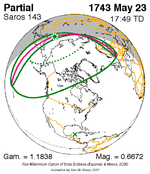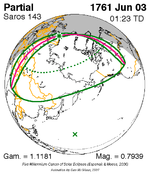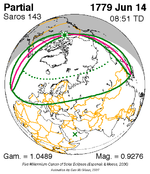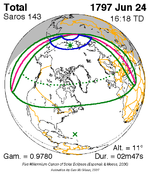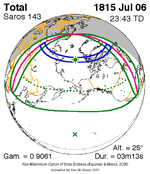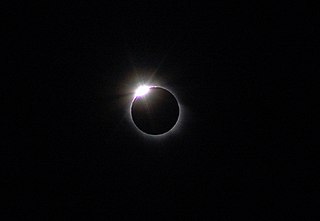
A total solar eclipse occurred on March 29, 2006. A solar eclipse occurs when the Moon passes between Earth and the Sun, thereby totally or partly obscuring the image of the Sun for a viewer on Earth. A total solar eclipse occurs when the Moon's apparent diameter is larger than the Sun's, blocking all direct sunlight, turning day into darkness. Totality occurs in a narrow path across Earth's surface, with the partial solar eclipse visible over a surrounding region thousands of kilometres wide. It was visible from a narrow corridor which traversed half the Earth. The magnitude, that is, the ratio between the apparent sizes of the Moon and that of the Sun, was 1.052, and it was part of Saros 139.

A total solar eclipse occurred on 11 August 1999 with an eclipse magnitude of 1.0286. A solar eclipse occurs when the Moon passes between Earth and the Sun, thereby totally or partly obscuring the image of the Sun for a viewer on Earth. A total solar eclipse occurs when the Moon's apparent diameter is larger than the Sun's, blocking all direct sunlight, turning day into darkness. Totality occurs in a narrow path across Earth's surface, with the partial solar eclipse visible over a surrounding region thousands of kilometres wide. The path of the Moon's shadow began in the Atlantic Ocean and, before noon, was traversing the southern United Kingdom, northern France, Belgium, Luxembourg, southern Germany, Austria, Slovenia, Croatia, Hungary, and northern FR Yugoslavia (Vojvodina). The eclipse's maximum was at 11:03 UTC at 45.1°N 24.3°E in Romania ; and it continued across Bulgaria, the Black Sea, Turkey, northeastern tip of Syria, northern Iraq, Iran, southern Pakistan and Srikakulam in India and ended in the Bay of Bengal.

A solar eclipse occurs when a portion of the Earth is engulfed in a shadow cast by the Moon which fully or partially blocks sunlight. This occurs when the Sun, Moon and Earth are aligned. Such alignment coincides with a new moon (syzygy) indicating the Moon is closest to the ecliptic plane. In a total eclipse, the disk of the Sun is fully obscured by the Moon. In partial and annular eclipses, only part of the Sun is obscured.

A total solar eclipse occurred at the ascending node of the Moon's orbit on Tuesday, July 2, 2019, with an eclipse magnitude of 1.0459. Totality was visible from the southern Pacific Ocean east of New Zealand to the Coquimbo Region in Chile and Central Argentina at sunset, with the maximum of 4 minutes 33 seconds visible from the Pacific Ocean. The Moon was only 2.4 days before perigee, making it fairly large.

A total solar eclipse occurred at the Moon's ascending node on 3 November 2013. It was a hybrid eclipse of the Sun with a magnitude of 1.0159, with a small portion over the western Atlantic Ocean at sunrise as an annular eclipse, and the rest of the path as a narrow total solar eclipse. A solar eclipse occurs when the Moon passes between Earth and the Sun, thereby totally or partly obscuring the image of the Sun for a viewer on Earth. A hybrid solar eclipse occurs when the Moon's apparent diameter is smaller than the Sun's in sunrise and sunset, but at Greatest Eclipse the Moon's apparent diameter is larger than the Sun's.

A total solar eclipse occurred on October 24, 1995. A solar eclipse occurs when the Moon passes between Earth and the Sun, thereby totally or partly obscuring the image of the Sun for a viewer on Earth. A total solar eclipse occurs when the Moon's apparent diameter is larger than the Sun's, blocking all direct sunlight, turning day into darkness. Totality occurs in a narrow path across Earth's surface, with the partial solar eclipse visible over a surrounding region thousands of kilometres wide. The path of totality went through Iran, Afghanistan, Pakistan, India, southwestern tip of Bangladesh, Burma, Thailand, Cambodia, Vietnam, Spratly Islands, northeastern tip of Sabah of Malaysia, Philippines and Indonesia.

A total solar eclipse occurred at the Moon's ascending node of the orbit on June 11, 1983. A solar eclipse occurs when the Moon passes between Earth and the Sun, thereby totally or partly obscuring the image of the Sun for a viewer on Earth. A total solar eclipse occurs when the Moon's apparent diameter is larger than the Sun's, blocking all direct sunlight, turning day into darkness. Totality occurs in a narrow path across Earth's surface, with the partial solar eclipse visible over a surrounding region thousands of kilometres wide. Occurring only 48 hours before perigee, the Moon's apparent diameter was larger.

A total solar eclipse will occur on December 5, 2048. A solar eclipse occurs when the Moon passes between Earth and the Sun, thereby totally or partly obscuring the image of the Sun for a viewer on Earth. A total solar eclipse occurs when the Moon's apparent diameter is larger than the Sun's, blocking all direct sunlight, turning day into darkness. Totality occurs in a narrow path across Earth's surface, with the partial solar eclipse visible over a surrounding region thousands of kilometres wide.

A total solar eclipse occurred on October 23, 1976. A solar eclipse occurs when the Moon passes between Earth and the Sun, thereby totally or partly obscuring the image of the Sun for a viewer on Earth. A total solar eclipse occurs when the Moon's apparent diameter is larger than the Sun's, blocking all direct sunlight, turning day into darkness. Totality occurs in a narrow path across Earth's surface, with the partial solar eclipse visible over a surrounding region thousands of kilometres wide. This total solar eclipse began at sunrise in Tanzania near the border with Burundi, with the path of totality passing just north of the large Tanzanian city of Dar es Salaam. It then crossed the Indian Ocean, passing St. Pierre Island, Providence Atoll and Farquhar Atoll of Seychelles before making landfall in southeastern Australia. The largest city that saw totality was Melbourne. After leaving the Australian mainland, the path of totality left the Earth's surface just north of the north island of New Zealand.
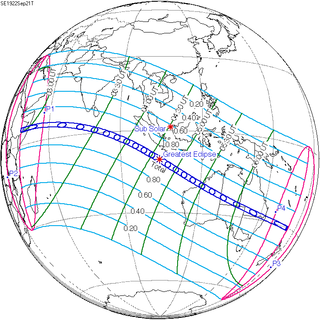
A total solar eclipse occurred on September 21, 1922. A solar eclipse occurs when the Moon passes between Earth and the Sun, thereby totally or partly obscuring the image of the Sun for a viewer on Earth. A total solar eclipse occurs when the Moon's apparent diameter is larger than the Sun's, blocking all direct sunlight, turning day into darkness. Totality occurs in a narrow path across Earth's surface, with the partial solar eclipse visible over a surrounding region thousands of kilometres wide. The greatest eclipse occurred exactly at perigee.
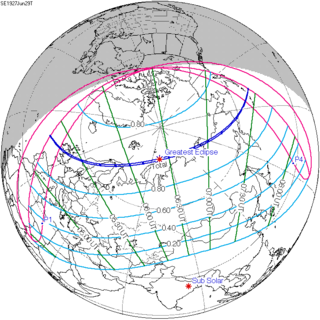
A total solar eclipse occurred on June 29, 1927. A solar eclipse occurs when the Moon passes between Earth and the Sun, thereby totally or partly obscuring the image of the Sun for a viewer on Earth. A total solar eclipse occurs when the Moon's apparent diameter is larger than the Sun's, blocking all direct sunlight, turning day into darkness. Totality occurs in a narrow path across Earth's surface, with the partial solar eclipse visible over a surrounding region thousands of kilometres wide. The path of totality crossed far northern Europe and Asia, including the United Kingdom, Norway, Sweden, Finland and Soviet Union on June 29th (Wednesday), and finally passed Amukta in Alaska on June 28th (Tuesday). This was the first total eclipse visible from British mainland soil for 203 years. This eclipse is referenced in the closing pages of Dorothy L. Sayers' novel Unnatural Death.

A total solar eclipse occurred on May 30, 1965. A solar eclipse occurs when the Moon passes between Earth and the Sun, thereby totally or partly obscuring the image of the Sun for a viewer on Earth. A total solar eclipse occurs when the Moon's apparent diameter is larger than the Sun's, blocking all direct sunlight, turning day into darkness. Totality occurs in a narrow path across Earth's surface, with the partial solar eclipse visible over a surrounding region thousands of kilometres wide. Totality was visible from northwestern Northland Region in New Zealand on May 31st (Monday), and Manuae in Cook Islands, Manuae and Motu One in French Polynesia, and Peru on May 30th (Sunday).
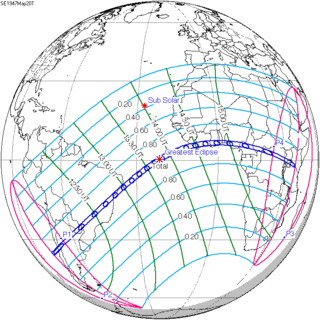
A total solar eclipse occurred on May 20, 1947. A solar eclipse occurs when the Moon passes between Earth and the Sun, thereby totally or partly obscuring the image of the Sun for a viewer on Earth. A total solar eclipse occurs when the Moon's apparent diameter is larger than the Sun's, blocking all direct sunlight, turning day into darkness. Totality occurs in a narrow path across Earth's surface, with the partial solar eclipse visible over a surrounding region thousands of kilometres wide. Totality was visible from Chile including the capital city Santiago, Argentina, Paraguay, Brazil, Liberia, French West Africa, British Gold Coast including capital Accra, French Togoland including capital Lomé, British Nigeria including capital Lagos, French Cameroons, French Equatorial Africa, Belgian Congo, British Uganda, British Tanganyika, and British Kenya. The southern part of Aconcagua, the highest mountain outside Asia, and Iguazu Falls, one of the largest waterfalls systems in the world, lie in the path of totality.

A total solar eclipse occurred on May 9, 1929. A solar eclipse occurs when the Moon passes between Earth and the Sun, thereby totally or partly obscuring the image of the Sun for a viewer on Earth. A total solar eclipse occurs when the Moon's apparent diameter is larger than the Sun's, blocking all direct sunlight, turning day into darkness. Totality occurs in a narrow path across Earth's surface, with the partial solar eclipse visible over a surrounding region thousands of kilometres wide. Totality was visible from Dutch East Indies, Federated Malay States, Siam, French Indochina, Spratly Islands, Philippines, and South Seas Mandate in Japan.

A total solar eclipse occurred on September 10, 1923. A solar eclipse occurs when the Moon passes between Earth and the Sun, thereby totally or partly obscuring the image of the Sun for a viewer on Earth. A total solar eclipse occurs when the Moon's apparent diameter is larger than the Sun's, blocking all direct sunlight, turning day into darkness. Totality occurs in a narrow path across Earth's surface, with the partial solar eclipse visible over a surrounding region thousands of kilometres wide.
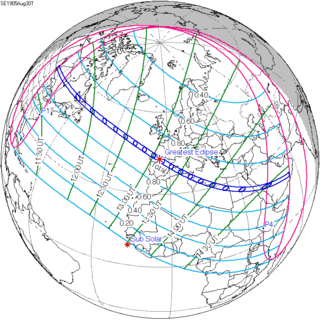
A total solar eclipse occurred on August 30, 1905. A solar eclipse occurs when the Moon passes between Earth and the Sun, thereby totally or partly obscuring the image of the Sun for a viewer on Earth. A total solar eclipse occurs when the Moon's apparent diameter is larger than the Sun's, blocking all direct sunlight, turning day into darkness. Totality occurs in a narrow path across Earth's surface, with the partial solar eclipse visible over a surrounding region thousands of kilometres wide. Totality was visible from Canada, Newfoundland Colony, Spain, French Algeria, French Tunisia, Ottoman Tripolitania include the capital Tripoli, Egypt, Ottoman Empire include Mecca, Emirate of Jabal Shammar, Aden Protectorate, and Muscat and Oman.
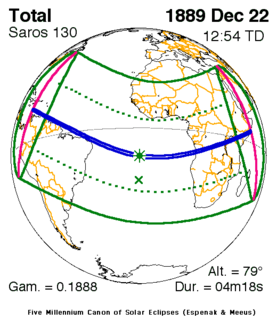
A total solar eclipse occurred on December 22, 1889. A solar eclipse occurs when the Moon passes between Earth and the Sun, thereby totally or partly obscuring the image of the Sun for a viewer on Earth. A total solar eclipse occurs when the Moon's apparent diameter is larger than the Sun's, blocking all direct sunlight, turning day into darkness. Totality occurs in a narrow path across Earth's surface, with the partial solar eclipse visible over a surrounding region thousands of kilometres wide. It was visible from Cuba, to the coast of Brazil, and across southern Africa.

A total solar eclipse occurred on August 7, 1869. A solar eclipse occurs when the Moon passes between Earth and the Sun, thereby totally or partly obscuring the image of the Sun for a viewer on Earth. A total solar eclipse occurs when the Moon's apparent diameter is larger than the Sun's, blocking all direct sunlight, turning day into darkness. Totality occurs in a narrow path across Earth's surface, with the partial solar eclipse visible over a surrounding region thousands of kilometres wide. It path of totality was visible from eastern Russia, Alaska, across Canada, and the northeastern United States. A partial eclipse occurred across all of North America.

A total solar eclipse occurred at the Moon's ascending node of the orbit on April 17, 1912. It is a hybrid event, starting and ending as an annular eclipse, with only a small portion of totality. A solar eclipse occurs when the Moon passes between Earth and the Sun, thereby totally or partly obscuring the image of the Sun for a viewer on Earth. A total solar eclipse occurs when the Moon's apparent diameter is larger than the Sun's, blocking all direct sunlight, turning day into darkness. Totality occurs in a narrow path across Earth's surface, with the partial solar eclipse visible over a surrounding region thousands of kilometres wide.
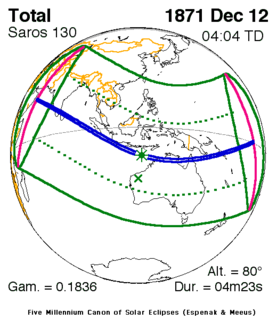
A total solar eclipse occurred on December 12, 1871. A solar eclipse occurs when the Moon passes between Earth and the Sun, thereby totally or partly obscuring the image of the Sun for a viewer on Earth. A total solar eclipse occurs when the Moon's apparent diameter is larger than the Sun's, blocking all direct sunlight, turning day into darkness. Totality occurs in a narrow path across Earth's surface, with the partial solar eclipse visible over a surrounding region thousands of kilometres wide.




